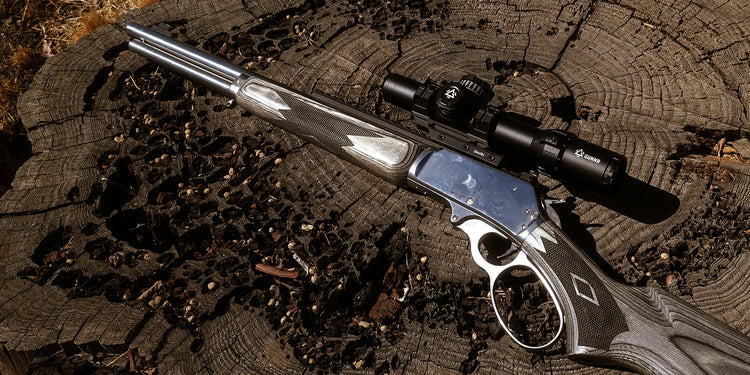Tactical Shooting Competition Breakdown: Differences Between IPSC, 3-Gun, PRS, and USPSA
1. Introduction
Tactical shooting competitions test a shooter's speed, accuracy, and decision-making under pressure. These competitions range from dynamic, close-range pistol matches to long-range precision rifle events.
This guide breaks down the most popular shooting competitions: IPSC, 3-Gun, PRS, and USPSA, comparing their rules, required skills, and recommended gear.
2. Tactical Shooting Competitions Comparison
|
Competition |
Main Focus |
Firearms Used |
Shooting Distance |
Scoring Method |
Movement & Tactical Skills |
|
IPSC |
Speed & accuracy |
Handgun, rifle, shotgun |
Short to medium |
Time + accuracy |
Rapid reloading, movement shooting |
|
3-Gun |
Multi-gun transition & dynamic shooting |
Handgun, rifle, shotgun |
Short to long |
Time + target engagement |
Tactical switching, various shooting positions |
|
PRS |
Long-range precision |
Precision rifle |
500-1200 yards |
Target hits + time constraints |
Wind reading, ballistic calculations |
|
USPSA |
Speed & tactical shooting |
Handgun |
Short range |
Time + accuracy |
Fast draw, dynamic reloads |
3. In-Depth Breakdown of Each Competition
3.1 IPSC (International Practical Shooting Confederation)
Key Features:
- Focuses on accuracy, speed, and power.
- Stages require strategic movement and quick decision-making.
- Divided into divisions such as Production, Open, and Standard.
Who It's For: Beginners and advanced shooters wanting to enhance dynamic shooting skills.
Recommended Gear:
Handguns: CZ Shadow 2, Glock 34 (Production Division)
Optics: Red dot sights (Open Division)
3.2 3-Gun (Multi-Gun Shooting Competition)
Key Features:
- Requires fast transitions between pistol, rifle, and shotgun.
- Includes multiple types of targets and shooting angles.
- Shooters must adapt their strategy to different firearms.
Who It's For: Competitors wanting to improve tactical and multi-weapon skills.
Recommended Gear:
Rifle: AR-15 chambered in .223 Remington, LPVO (1-6x scope)
Handgun: Full-size 9mm pistols
Shotgun: Semi-auto shotgun (Benelli M2 Tactical)
3.3 PRS (Precision Rifle Series)
Key Features:
- Focused on long-range precision shooting (500-1200 yards).
- Emphasizes ballistic calculations and environmental adjustments.
- Shooters use bolt-action rifles with high-power scopes.
Who It's For: Precision shooting enthusiasts and those looking to improve their long-range marksmanship.
Recommended Gear:
Rifle: Bolt-action chambered in 6.5 Creedmoor or .308 Win
Optics: FFP high-magnification scopes
3.4 USPSA (United States Practical Shooting Association)
Key Features:
- Fast-paced, handgun-only competition.
- Requires quick draws, target transitions, and reloads.
- Scoring is based on accuracy and speed.
Who It's For: Ideal for beginners and those refining close-range shooting techniques.
Recommended Gear:
Handgun: Glock 17, Staccato P
Optics: Red dot sights
4. Choosing the Right Competition
How to Decide?
Your Goal & Interests:
- Interested in multi-gun transitions? ➡️ 3-Gun
- Prefer long-range precision? ➡️ PRS
- Want dynamic close-range shooting? ➡️ USPSA/IPSC
Budget:
- IPSC/USPSA are cost-effective entry points.
- PRS requires higher-end rifles and optics.
Time Commitment:
- Tactical competitions (IPSC, USPSA, 3-Gun) need more movement training.
- Precision shooting (PRS) requires ballistic study and environmental assessment.
5. Key Considerations & Safety Tips
- Know the Rules: Each competition has specific firearm and safety requirements.
- Train Regularly: Practice reloads, transitions, and shooting techniques.
- Use Proper Gear: Ensure your firearms and optics meet competition standards.
- Follow Safety Guidelines: Always keep the muzzle in a safe direction and follow range commands.
- Be Patient: Tactical shooting is a skill that improves with experience.
6. Conclusion
This guide provides an overview of the differences between IPSC, 3-Gun, PRS, and USPSA.
Shooters can choose the best competition based on their skills, interests, and goals.
To gain real experience, consider joining a shooting club, taking training courses, and attending matches.
- Choosing a selection results in a full page refresh.


